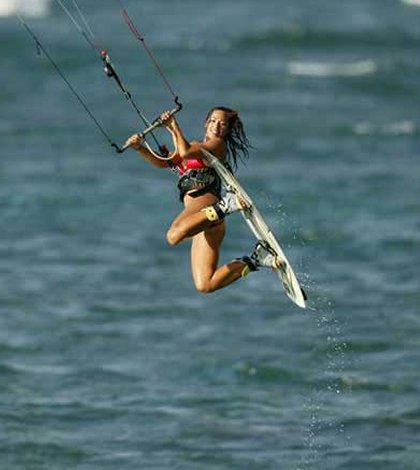Kitesurfing, also known as kiteboarding, is the most amazing and fastest growing water sport in the world. Kiteboarding is practiced in the water, mostly in oceans since a lot of wind power is required to practice this water sport. But like all other sports this one also needs some training, as well as the requirement to wear and use equipment according to the local wind and water conditions.
As a complete novice in the field of kitesurfing learning to pilot the kite is the first thing you must learn before you even think of getting up on a board. In order to learn piloting a kite in a safe way one should stick to a small trainer kite instead of using real inflatable kites. So start practice with a trainer kite until you can maneuver it effortless and be able to fly it in figures of eights without crashing it to the ground. Next step is to swap to the larger inflatable kite. If the tension of the steering lines is shifted when flying the kite then the kite turns left or right accordingly. So while flying you must just must tighten the steering lines and pull on one side of the bar in order to initiate a turn to the left or right. This maneuver is similar to riding a bicycle. You should not under any circumstances turn the bar around its centerlines like a steering wheel, back and forward or sideways, else you´ll encounter issues and you might suffer serious consequences.
For beginners it is always advisable to have a kitesurfing instructor present, who will demonstrate and show the various areas of power in the wind window and how to control the kite such as when to increase or reduce the wind power while flying. One must know the safety rules and the function of the safety devices as it will be very important in case of an emergency. Beginners should take time to really learn the use of the control bar safety system which every modern kite is equipped with, preferably before getting into the water. You must be aware of the safety systems and have full understanding for the general safety procedures taken when for instance launching the kite, as this is very important. If you find that there are deficiencies in the particular kite you’re using then you shouldn’t under any circumstances use it, but get a newer kite with an adequate safety system.
The different companies that manufacture the kites usually have slightly different safety systems so you must read the guidelines and if necessary consult a more experienced rider to understand them before you start your practice. Again, it is very important that you first learn the fundamentals for piloting the kite and how to totally depower the kite in case you end up in any kind of emergency. To depower the kite you must first simply release the control bar. Then you need to activate the quick release to flag out the kite completely. Remember that the leash that connects you to the kite itself always shall be connected to your harness and the connection point on the bar control system, from the moment you launch the kite until you land it. During your first rides you may find that you’re not able to handle the power from the kite. Then you must not hesitate to activate the quick release. Make sure to wear a life jacket and a helmet during your first practice sessions and preferably also as a more experienced rider.
Performing kitesurfing tricks with your kite is cool, but don’t expect to do this before you have learned to ride effortless in both directions as well as the ability to ride upwind. When you can do this then you can enliven your sessions and make them more challenging by performing various tricks. Your first kitesurfing trick will most likely be to ride toeside. Next trick will probably be the backroll or a simple jump. Once you start jumping there are almost an endless number of tricks you can perform!
Gustav Ljungberg


















